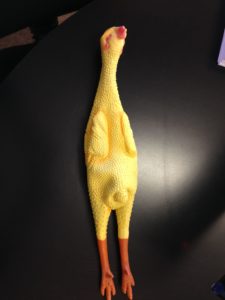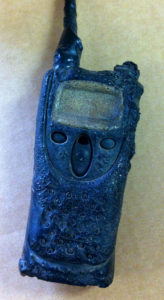rough treatment or poorly packed?
 Some days when boxes arrive from all over the country with radios for repair there will be one like this example. A slightly crushed, broken open package. The investigation begins! Questions arise: What’s inside? Is it damaged? Do we think anything is missing? Who does it belong to? Where’s the camera? The fact the radios inside were coming for repair anyway helps alleviate some of the problem. If it is broken, the technicians in the repair facility have a good chance of fixing it. (They are good that way!) With a little detective work it usually doesn’t take long to determine who sent the package, and what the contents should be.
Some days when boxes arrive from all over the country with radios for repair there will be one like this example. A slightly crushed, broken open package. The investigation begins! Questions arise: What’s inside? Is it damaged? Do we think anything is missing? Who does it belong to? Where’s the camera? The fact the radios inside were coming for repair anyway helps alleviate some of the problem. If it is broken, the technicians in the repair facility have a good chance of fixing it. (They are good that way!) With a little detective work it usually doesn’t take long to determine who sent the package, and what the contents should be.
The package in the picture happened to have two mobile (vehicle install style) radios inside. Thankfully, it didn’t appear anything was missing or severely damaged. The customer’s paperwork was intact. The radios were checked in, repaired, and shipped back to the customer with in a few days. Yet this box can serve as a good example for those shipping radios in. Here are some points to ponder and suggestions:
- Mobile radios and other heavy devices can be double boxed (a box within a box) or wrapped well with bubble wrap, to prevent them from banging together or shooting out the side of the box during rough shipping.
- Use plenty of packing materials to make the box more rigid. Whether you use packing peanuts or bubble wrap, make the package tight. The contents have more of a chance of arriving at their destination intact. (You never know when an elephant-sized box might be sitting atop your box during shipping.)
- Save money! Most carriers now charge by dimensional weight (height x width x length, divided by $$ = UPS dimensional wt.) instead of actual weight. To keep shipping costs down, use the smallest box possible, while still maintaining 1″ of packing around your cargo.
- Remove extra labels when reusing shipping boxes to prevent the box from boomeranging back to you. The box in the example had both a label addressed to the Delmmar Radio Repair Center and a label from when someone else sent the box to our customer.
- Expedite your repairs by enclosing a copy of the Radio Repair Form and/or a packing slip letting us know who is sending them and pertinent information needed to get the radios repaired and on their way home.
It’s our job, everyday, waiting and watching for those boxes of all shapes and sizes to come in the door. Send us your radios, we will fix them and get them back to you as quick as possible.
If you have questions about radio repair give Delmmar Communications a call, we are happy to help, 800-872-2627.
~cl
 I’ve been working on the railroad…
I’ve been working on the railroad…





 Our customers in the nursery and greenhouse business are starting to prepare for Spring.
Our customers in the nursery and greenhouse business are starting to prepare for Spring. 

